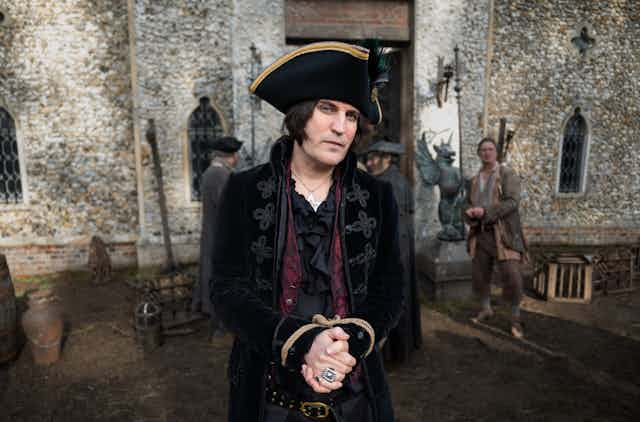As the title of the new TV series makes abundantly clear, it is offering viewers the Completely Made-Up Adventures of Dick Turpin, and we are not supposed to consider Noel Fielding’s depiction of a charming but hapless villain as authentic. Dick Turpin was one of the many robbers on horseback in 18th-century England who stalked the roads and held up travellers with the command: “Stand and deliver!”
For a time, he was the most wanted criminal in the country and was eventually executed in York in 1739, aged 33. The latest retelling of the Dick Turpin story is just one in a long line of fictionalised accounts. All of these portrayals don’t truly reflect the real Dick Turpin.
Fielding’s new portrayal of Turpin is far removed from the Victorian romanticisation of the swashbuckling highwayman and instead turns the central character into a comedic figure. While this is a different take, it is still guilty of presenting the violent and treacherous robber and murderer as a romantic and appealing figure.
Here are five myths about him from popular culture.
1. He was a knight of the road
The characterisation of Turpin as an honourable “knight of the road” behaving chivalrously was the invention of Victorian authors and artists (like William Harrison Ainsworth). At this time highway robberies were no longer a constant threat and these authors and artists recast these criminals as romantic heroes akin to Robin Hood. In Ainsworth’s Rookwood (1834), the character of Dick Turpin is a likeable figure living a glamorous and exciting life as a member of a criminal gang.
Eighteenth-century criminal biographies, however, portray the real Richard Turpin as a violent poacher, robber, murderer and horse thief who stole from rich and the poor. In the 1735 Earlsbury Farm Robbery, the Gregory Gang, including Turpin, tortured their elderly male victim, forcing him to sit, bare-buttocked on a lit fire while Samuel Gregory raped the female servant.
2. He was handsome
Far from being a handsome highwayman popular with ladies, contemporary accounts of Turpin from 1737 described him as “about five feet nine inches high, brown complexion, very much mark’d with the small pox, his cheek-bones broad, his face thinner towards the Bottom, his visage short, pretty upright, and broad about the Shoulders”.
The violent, pockmarked thug of the 1730s was nothing like the modern images of an attractive rogue embodied by actors and pop stars like Adam Ant in his song Stand and Deliver.
3. He was captured for his crimes as a highway robber
Dick Turpin was living in York under the alias John Palmer when he was eventually captured – but not for highway robbing. He had got into a petty quarrel that resulted in him killing his neighbour’s rooster and threatening to shoot the neighbour.
While being held at Beverley House of Correction magistrates, he was investigated further and Palmer was charged with three counts of horse theft.
Turpin hoped to escape justice by securing a false alibi from his brother-in-law in Essex but, unlucky for him, his former school tutor recognised the handwriting on the letter he sent and then travelled to York to reveal that Palmer and Turpin were the same person and to claim a £200 reward.
4. He had a noble steed
Accounts from Victorian authors and artists that Turpin rode a loyal mare, Black Bess, between Essex and York overnight to escape capture are both fictitious and impossible (and highly sentimentalised). Ainsworth in Rookwood invented the journey to create a dramatic escape for Turpin, despite this having little relevance to the novel’s plot. And he ignores the fact that Turpin had been living as Palmer in York for over a year before his capture.
5. He was a celebrity
Richard Turpin was not a “celebrity” in the 18th century. Attention focused on his and the Gregory Gang’s crimes while he was at large due to the offer of rewards, but he was soon forgotten following his capture. Contemporary accounts demonstrate that he paid for mourners to be present at his execution to ensure an audience and the survival of only a couple of criminal biographies indicate that there was little public interest beyond the norm for violent criminals.
Without Harrison Ainsworth having written the largely fictional figure of Dick Turpin into his novel Rookwood and spurring the creation of a myth, the executed criminal Richard Turpin would have been overlooked other than by historians of crime.

Looking for something good? Cut through the noise with a carefully curated selection of the latest releases, live events and exhibitions, straight to your inbox every fortnight, on Fridays. Sign up here.

